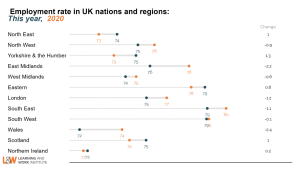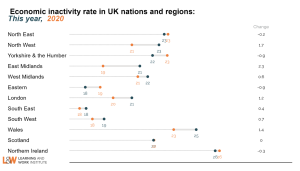May 2023
1. Real earnings continue to decline
The latest data show average regular earnings grew by 6.7% in the year to March 2023. For public sector workers average regular earnings grew by 5.6%, while average regular earnings grew by 7.0% for private sector workers. However, high inflation means real regular earnings fell by 2.0% (3-month average change) in the year to March 2023. Inflation increased in February and then decreased only marginally in March, breaking a 3-month trend of falling inflation seen from October 2022 to January 2023. CPIH rose from 8.8% in January to 9.2% in February, decreasing slightly to 8.9% in March. Core CPIH (excluding energy, food, alcohol and tobacco) also increased from 5.3% in January to 5.7% in February and was unchanged in March. The UK has become something of an outlier, suffering from persistently high inflation, compared with other advanced economies such as the United States, Germany or France. The causes of prolonged post-pandemic inflation are coming under increasing scrutiny due to concerns that some companies are expanding their profit margins following the recent wave of inflation caused by supply-chain bottlenecks that have mostly now been resolved. MPs are scheduled to investigate the influence of food producers and major supermarkets on food price inflation, which has reached levels unseen since the 1970’s.
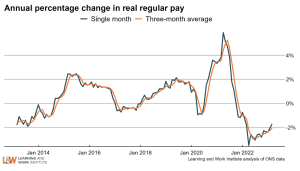
2. There are fewer potential workers for employers to recruit, with 583,000 fewer over 50s in the labour market since the pandemic started
Recruitment is more challenging for employers because of rises in economic inactivity – people leaving the labour market. This has been primarily driven by those aged 50 and over and people with long-term health problems and disabilities. The number of people aged 50-64 who are economically inactive has increased by 10.1% since the pandemic started.
Economic inactivity fell in the most recent quarter, though driven more by reductions in the number of young people in education than older people returning to the labour market. The challenge remains: the number of those aged 16-64 who are economic inactive is 361,000 higher than pre-pandemic, yet only one in ten out-of-work older people and disabled people get employment support each year. The Government needs to extend employment support to more people outside the labour market and employers need to think about recruitment and job design to attract and retain staff.
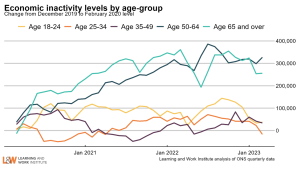
3. Current levels of economic activity have many causes
Post-pandemic increases in economic inactivity have been heavily influenced by the numbers of individuals inactive due to long-term health problems, which have increased by 20.7% since the December 2019 to February 2020 quarter. Other important contributors to economic inactivity include students, whose numbers have risen by 2.3% since the start of the pandemic. By contrast, the number of individuals inactive due to family / home responsibilities has decreased by 9.8%, and the number of individuals who are retired has decreased by 3.5% over the same period. The number of economically inactive individuals who do not want to work has increased by 6.9% since the start of the pandemic, whilst the number of economically inactive individuals who do want to work has decreased by 4.8%.
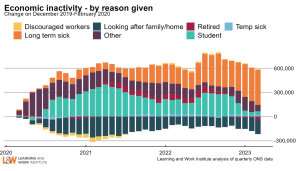
4. Quarterly data for employment across ethnic groups, disability status and net labour market flows show some evidence of labour market recovery
The latest employment data for different ethnic groups shows that the employment rate for people from a Bangladeshi background is substantially higher than the pre-pandemic level, now at 62.7% compared with 58.2% in the January to March 2020 quarter. Employment rates for those from Indian and Chinese backgrounds are also higher than pre-pandemic levels. Those who consider themselves to be White, Black/ African/ Caribbean/ Black British or from Mixed/ multiple ethnic groups are less likely to be in employment now than before the pandemic.
The latest disability employment data shows that the unemployment rate for people with disabilities is falling again after it rose in the previous three quarters. At 6.2%, it is below the pre-pandemic level.
The latest data on labour market flows shows that net flows to employment have now remained positive for nine quarters in a row and have increased for the past three quarters. However, net flows to employment in the first quarter of 2023 were around 100,000 smaller than those seen in quarters two and three of 2021.
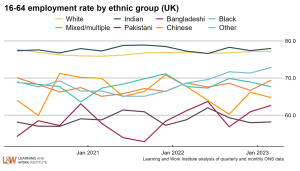
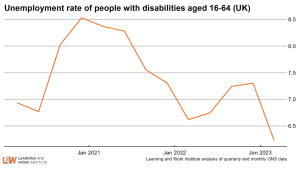
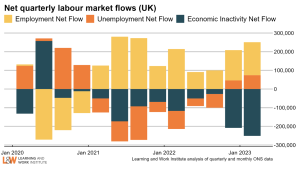
5. The employment picture varies across the country
Employment rates this quarter are higher than the equivalent quarter in 2020 in the North East, Yorkshire and the Humber, Eastern England, Scotland and Northern Ireland, but are lower everywhere else. Economic inactivity this quarter is higher than the equivalent quarter in 2020 everywhere except the North East, Yorkshire and the Humber, Eastern England, Scotland, and Northern Ireland. This varying picture, which is even greater at sub-regional level, shows the importance of tackling inequalities so everyone has a fair chance in life wherever they live.
